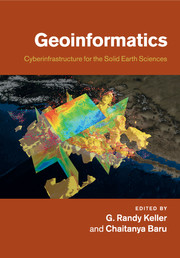Book contents
- Frontmatter
- Contents
- List of contributors
- Preface
- Introduction
- 1 Science needs and challenges for geoinformatics
- 2 Introduction to IT concepts and challenges
- Part I Case studies from other disciplines
- Part II Modeling software and community codes
- Part III Visualization and data representation
- Part IV Knowledge management and data integration
- Part V Web services and scientific workflows
- Part VI Emerging international and other efforts
- Index
- Plate section
- References
1 - Science needs and challenges for geoinformatics
from Introduction
Published online by Cambridge University Press: 25 October 2011
- Frontmatter
- Contents
- List of contributors
- Preface
- Introduction
- 1 Science needs and challenges for geoinformatics
- 2 Introduction to IT concepts and challenges
- Part I Case studies from other disciplines
- Part II Modeling software and community codes
- Part III Visualization and data representation
- Part IV Knowledge management and data integration
- Part V Web services and scientific workflows
- Part VI Emerging international and other efforts
- Index
- Plate section
- References
Summary
What is geoinformatics?
Before we can begin to discuss geoscience informatics needs and challenges, we must first explain our use of the term geoinformatics for the purposes of this book. Over the past decade geoinformatics has become a term that has been independently employed by groups in several geospatial and geoscience fields around the world. In addition, this word appears in the title of several periodical publications. For example, there is an online magazine named GeoInformatics (www.geoinformatics.com) and an International Journal of Geoinformatics (www.j-geoinfo.net) that primarily focus on geospatial data and analysis within a geographic information system (GIS) framework. However, our emphasis in this book is on the data, software tools, and computational infrastructure that are needed to facilitate studies of the structure, dynamics, and evolution of the solid Earth through time, as well as the processes that act upon and within it from the near surface to the core. To approach such challenges, we must not only think and work in 3-D spatially, but we must include a 4th dimension, time. Time in this case ranges from seconds, such as in an earthquake, to millions of years, such as in plate movements over the Earth. Here we have usedgeoinformaticsto describe a variety of efforts to promote collaboration between computer scientists and geoscientists to solve complex scientific questions.
- Type
- Chapter
- Information
- GeoinformaticsCyberinfrastructure for the Solid Earth Sciences, pp. 3 - 9Publisher: Cambridge University PressPrint publication year: 2011
References
- 1
- Cited by



